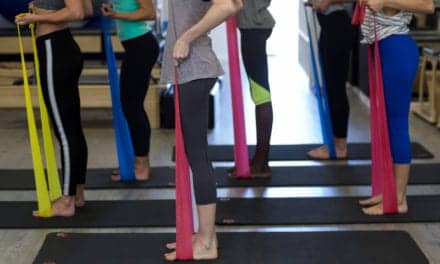PHOTO CAPTION: A combination of enjoyable exercises and positive feedback can help motivate clients to increase their activity and improve performance.
Now more than ever, it’s important for clients to counteract the effects of a sedentary lifestyle by increasing movement.
By Rosemary Peng, PT, MSPT
Three years ago, I wrote an article about the increasing sedentary lifestyle around the globe and its effects on public health. I never would have predicted that a global pandemic would occur in my lifetime, let alone that it would last for 2 years. Yet here we are, entering the third year of the COVID-19 pandemic with continuing effects on public health as seen through social, emotional, and physical lenses. It seems like a good time to revisit this topic with added importance because of the 2-year health and safety restrictions imposed to prevent deaths from COVID-19-related illness.
Throughout history, humans have been inventing machines and devices to improve work capacity and efficiency. In the last 50 years, computers and their applications have fundamentally changed our school, work, and recreational lives.
Consequences of Convenience
One consequence of this increased convenience is the reduction in the need for humans to move their bodies for work, school, or fun. This is illustrated by a statistic published in 1969 that reported 40% of school-age children walked or rode their bikes to school. By 2001, that number dropped to 13% as more children were driven to school.1 Sedentary patterns aren’t just limited to the United States. Other countries are seeing similar trends of declining physical activity. In Japan, for example, a study of more than 2,000 adults older than age 40 years showed that 50% of waking time was sedentary.2
Contributing to the increased amount of sedentary behavior is not only the use of cars to move from place to place, but also the use of technology and services for work, daily chores, and activities. The percentage of high-activity jobs showed a decrease and low-activity jobs showed an increase in the years between 1970 and 2000.1 In recent years, the availability of technology and services has reduced the time spent doing daily chores that once required physical activity. Robots now vacuum and cut the lawn. Clicking a computer can send groceries to the store curb or a shopper’s front door. A touch of the button not only changes the channel of the TV, but opens the garage door, turns on the oven, and opens the blinds. Voice-activated devices are another way to perform activities that once required walking, standing, bending, and reaching.
Medical professionals see the effect of this decrease in physical activity in public health and well-being. A recent systematic review and meta-analysis looked at the effect of sedentary lifestyle on disease, hospitalization, and mortality in adults.3 It found that prolonged sedentary time was associated with deleterious health effects. As can be seen from research, despite humans’ cleverness in developing tools to reduce their need to move, the body needs to move for its own good.
Enter the COVID-19 Pandemic
Winter of 2020 changed our lives as the aggressive COVID-19 virus spread rapidly and immediately brought severe illness and death to communities around the globe. Protective health measures of public lockdowns, social distancing, and changes in work life were put in place immediately to protect life and prevent the spread of the disease caused by the virus. The result was even more sedentary behaviors including for those who were otherwise physically active. Schools became remote, so children were no longer getting exercise from walking to or within the school, physical education class, or after-school activities. Those who now worked from home had only to walk from one room to another in their home instead of walking even from the parking lot to the office. Community gyms and other physical recreational facilities were closed, and many who regularly participated no longer had access to exercise equipment. Although those strict measures to reduce death and disability have recently been modified and reduced, there are still ongoing measures that continue to reduce the physical activity of people around the world.
Many research articles and papers have since been written about the effect of the pandemic emergency measures on community health, including physical and mental health. One review paper published as early as September 2020 discussed the decline of physical activity caused by the confined lifestyle after the pandemic was declared, concluding that “practicing physical activities has a key role in the levels of physical fitness and is essential to balance and improve health and quality of life during the COVID-19 pandemic.”4 Another systematic review published in December 2020 found several health benefits from physical activity during the pandemic including reduction in stress level, improved sleep, decreased depression, and decreased anxiety in those who exercised regularly.5 Indeed, there are many research articles since these that describe the negative effects of the COVID-19 pandemic on the health of all age groups and the importance of improving physical activity today.
Four Principles
Therapists see the effects of sedentary life in the form of pain, joint or muscle injury, obesity, high blood pressure, diabetes, stroke, and osteoporosis. Therapists are in a position to educate and address the dysfunctions and adverse health effects that this sedentary lifestyle has created. Four principles can help therapists develop an exercise or activity prescription for patients of any age and medical condition.
1) Identify the patient’s prior fitness level. This requires not just questioning once but having ongoing discussion about what the patient’s typical day is like and how much movement they get at school, work, home, and in the community. How much exercise does the patient get in a typical week? One question that would be helpful is “How often do you sit during the day?” or “How much of the day do you sit?” Use objective measurements to determine the patient’s level of strength and fitness, such as the 6-Minute Walk Test, 30-Second Chair Stand, Five Times Sit to Stand, or 2-Minute Step Test.
2) Educate patients about the consequences of inactivity or being sedentary. Use stories and analogies to help create a picture for the patient of movement versus being sedentary. Discuss ways that they can increase movement in their day, even helping them to make smart choices of when to use versus when not to use available technology or services.
3) Progress exercise in a thoughtful, patient-specific manner. Patients that have a history of being more active can be progressed more quickly to higher levels of intensity and duration than patients that have a long history of being sedentary. One rep max test should be used when possible to determine appropriate resistance levels for strength training, and HR or RPE should be used to determine whether aerobic exercise is reaching the level needed for change.
4) Motivate and encourage patients to achieve a high level of exercise performance. A recent study of experts looked at features of physical activity apps that would improve participation in individual, recreational sports.6 Several features found that were important for effectiveness of app design to encourage use include fun or enjoyment, feedback and feedforward information, rewards, and social components. These features can be applied to physical therapy for improving patients’ effort and performance.
Fitness Can Be Fun
What is fun for one person is not necessarily fun for everyone. For example, one older patient who wants to stand for longer periods of time but who feels fatigue quickly may stand for longer periods of time while drawing a picture in an artist’s pad, while another may be more motivated by a Wii bowling game. A younger person who may be inactive and deconditioned may find fun in using a device that imitates sports, such as the Pro Fitter 3D Cross Trainer from Fitterfirst, Calgary, Alberta, Canada. This device allows the user to integrate the rhythmic weight transfer of skiing, as well as motions that build strength and balance among the 20 functional exercises it provides. For patients who may enjoy walking but want to begin a program in the clinic, an elliptical device that provides a natural walking motion such as the SXT7000 from Scifit, Tulsa, Okla, may be appropriate.
Crafts, music and dancing, board games, interactive video games, and virtual reality are some ways to make therapy enjoyable and transferable to home. New virtual reality screens are available on exercise bikes, treadmills, steppers, ellipticals, and balance machines that enhance the user’s level of enjoyment.
“Gamification” of therapy can include the use of interactive video games, which can be off-the-shelf options, such as Wii and Kinect, or new video games being developed for therapy use. Therapists are still involved in the treatment, watching and correcting form, or setting up the environment to promote the movement wanted.
Feedback can take many forms. Verbal feedback can always be given by the PT. But one benefit of technology is that exercise equipment now often comes with screens that provide feedback on performance. Gait trainer treadmills have graphic information such as footsteps and targets for stride length and cues to “take longer step right” to help. Many pieces of equipment provide information about mileage, step count, calories, and reps per minute. They may also have target options with visual feedback comparing the target to the performance. This information should be shared with the patients so that they have feedback about their performance with results that therapists can use to encourage progression on the next visit.
Power Of Positive Feedback
Rewards are very easy to provide, and patients of all ages respond to them. It can be as simple as a thumbs-up or “high five” sign, or more complicated such as points accrued on a video game. According to the study by design and IT professionals, the reward should be received regardless of the level of difficulty of the goal. Again, technology is increasing the availability of rewards for patients. For example, the Biodex gait trainer treadmill from Shirley, NY-headquartered Biodex Medical Systems Inc will provide rewards on the screen such as “good job” when the target stride length is reached. Treadmills and stepper machines that include a quarter-mile track on the screen provide rewards such as colored balls or arrows that light up the distance attained on the track. Even young children feel rewarded when they see the “green peas” on such a screen and want to continue walking to get another one.
Fit Lifestyle
While healthcare professionals are encountering an increasing challenge of a less fit society, a poorly conditioned body is not an inevitability. Physical therapists have a deep understanding of how the body functions, but also are in a position to get to know their patients and understand which activities and technologies are most likely to get them their buy-in. Combining these complementary components of care, physical therapists are well-positioned to move their patients to higher levels of fitness and, hopefully, toward a more fit lifestyle. PTP
Rosemary Peng, PT, MSPT, is a clinical specialist at Kessler Institute for Rehabilitation with specialties in neurology and pediatrics. She is a 1985 graduate of the Arcadia University PT program and has more than 30 years of experience in inpatient and outpatient rehabilitation, home care, early intervention, and school settings. For more information, contact [email protected].
References
- Brownson RC, Boehmer TK, Luke DA. Declining rates of physical activity in the United States: what are the contributors? Annu Rev Public Health. 2005;26:421-43
- Chen T, Kishimoto H, Honda T, et al. Patterns and levels of sedentary behavior and physical activity in a general Japanese population: the Hisayama study. J Epidemiol. 2018;28(5):260-265.
- Biswas A, Oh Pi, Faulkner GE, et al. Sedentary time and its association with risk for disease incidence, mortality, and hospitalization in adults: a systematic review and meta-analysis. Ann Internal Med. 2015;162(2):123-132.
- Pinho CS, Caria ACI, et al. The effect of the COVID-19 pandemic on levels of physical fitness. Rev Assoc Med Bras. 2020;66 Suppl 2:34 – 37. DOI: 10.1590/1806-9282.66.S2.34
- Violant-Holz V, Gallego-Jiminez MG, et al. Psychological health and physical activity levels during the COVID-19 pandemic: A Systematic Review. Int J Environ Res Public Health. 2020;17(24):9419. DOI: 10.3390/ijerph17249419
- Dallinga J, Janssen M, van der Werf J, Walravens R, Vos S, Deutekorn M. Analysis of the features important for the effectiveness of physical activity–related apps for recreational sports: expert panel approach. JMIR Mhealth Uhealth. 2018;6(1):1-12.
Product Resources
The following companies offer products that can be used for fitness programs of all types:
AlterG
www.alterg.com
Biodex Medical Systems
www.biodex.com
Dynatronics
www.dynatronics.com
Exertools
www.exertools.com
Fitter International
www.fitter1.com
HydroWorx
www.hydroworx.com
Magister Corp
www.magistercorp.com
OPTP
www.optp.com
Performance Health
www.performancehealth.com
SciFit
www.scifit.com
Sissel USA
www.sisselshop.com
Spirit Fitness
www.spiritfitness.com
Stretchwell
www.stretchwell.com
Theraband
www.theraband.com
VersaSlider
www.versaslider.com





